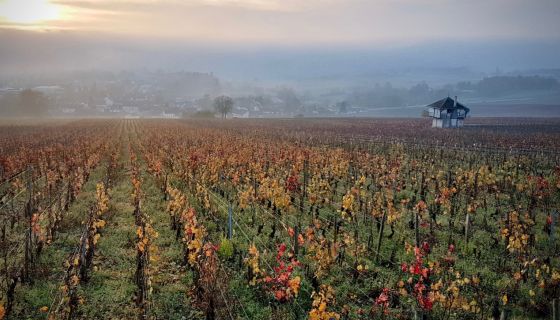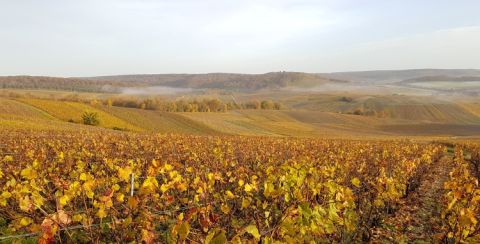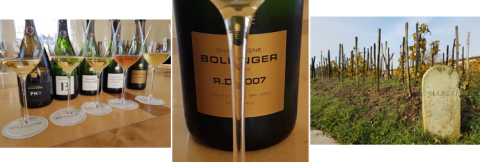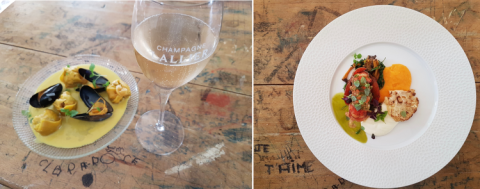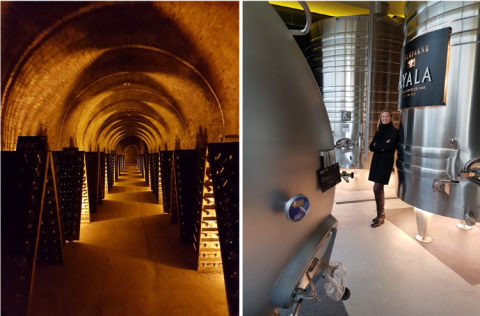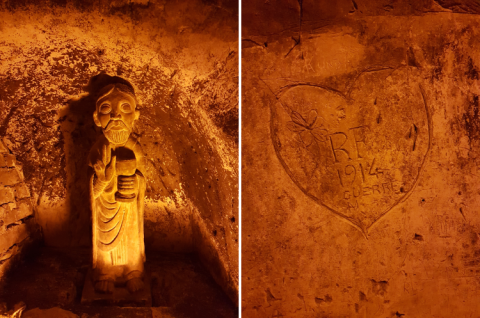One sunny evening last October, sipping something chilled and white, my peace was shattered by the unexpected collision of two facts: I was about to turn 42, and I had never visited either Champagne or Burgundy.
‘How the hell have you managed that?!’ was the wide-eyed reaction of my friend and former colleague Peter Robson. I really wasn’t sure how to answer. I’ve worked in wine pricing for 13 years, and both these regions figure prominently on lists of the world’s most expensive wines. The price of their wines has clearly been of interest to Purple Pagers, as witness the Burgundy prices forum thread, and news is that champagne prices this year are going through the roof.
Forty-two is an important birthday for everyone, although only Douglas Adams fans truly know why (Adams’ iconic Hitchhiker’s Guide to the Galaxy posited ‘42’ as the answer to ‘the Ultimate Question of Life, the Universe, and Everything’). I was about to reach this milestone birthday having visited every French wine region except two of the most famous and expensive.
In a year when I expected to have no wine travel at all, I started planning.
Champagne’s golden glow
Three weeks later (and several degrees colder), I found myself driving towards the dawn light, bound for the Channel Tunnel and northern France beyond. As the sky grew pink and orange with the sunrise, I wondered what Champagne would look like ‘in person’, particularly in late autumn. I would not be disappointed.
Around the Montagne de Reims, I was struck by how beautiful the area was. In places, the rolling topography could even be described as intricate, with ridges folding back on themselves creating sunlit promontories and sheltered sub-valleys. Even more striking than the topography was the consistent intensity of colour; the entire area looked as though it was reclining under a furrowed shroud of golden-bronze gauze. Gold seemed entirely apt as a dominant colour, given champagne’s recent price performance and its associations with unfettered luxury.
Bollinger HQ, as you might imagine, is paradise for the wine-loving James Bond fan. 007 memorabilia are dotted around the place, from the vintage film posters on the walls in the old cooperage to the hi-tech special-edition presentation cases in the reception area. My visit ended at hallowed ground – the Clos St-Jacques. This tiny walled vineyard is home to the pre-phylloxera vines that produce Bollinger’s super-exclusive cuvée Vieilles Vignes Françaises. If you can get your hands on a bottle (I didn’t), it would cost well over £1,000 – too pricey even for Bond?
Instead I enjoyed an early look at RD 2007, whose golden label (photograph below) states the bottle’s disgorgement date: ‘Dégorgé le 28 Mai 2021’ – Ian Fleming’s birthday. I haven’t yet established if this was a stroke of blind luck or of pure marketing genius.
New to me was Grande Année Rosé 2012, which was instantly Bollinger in style, being slightly oxidative, with savoury undertow lifted slightly by notes of baked strawberries. This immediately made me want to try it with rare-roasted duck breast. Fortunately, lunch was imminent.
Even the food in Champagne seemed to have an autumnal golden glow about it, most obviously in the relaxed, slightly hip environment at Avarum in Aÿ – a relatively new establishment recommended to me by the Bollinger team. Here, the gold was in the feather-light mustard foam that accompanied the beef-cheek amuse-bouche, the saffron sauce around the mussels (I asked for more mopping-up bread so as to enjoy every last drop), and the spiced pumpkin velouté that so neatly complemented the lobster tail.
The gold theme continued after lunch, at Bollinger’s sister winery, Ayala – both above ground and below. The neat rows of riddling racks in Ayala’s cellars date back to the days when the now-resurgent house was the champagne brand. Above ground, its super-technical winery glinted with clean lines and stainless steel – today’s Ayala is visibly forward-thinking. This modern focus is perhaps best encapsulated in the futuristic, stainless-steel, egg-shaped fermenter proudly shown to me by Caroline Latrive (Ayala’s chef de cave, photographed below). This impressive piece of one-off engineering was produced by a local metalwork specialist, and really does seem to reflect the Ayala house style. Looking at it reminds me particularly of their top cuvée, Perle d’Ayala – focused, modern and fresh with elegant breadth. Visiting Chardonnay-focused Ayala after Pinot-focused Bollinger (just a five-minute walk away) was an excellent way to compare house styles.
It was very much ‘back to the past’ for my final Champagne visit – Taittinger’s headquarters in Reims. Glowing amber in the dim light below were many centuries’ worth of history – religious relics and wartime etchings such as those in my photos below. The current building was constructed in 1920, on top of the remains of the Abbaye St Nicaise – a Benedictine monastery built in the 13th century and torn down in the early days of the French Revolution. The abbey’s original arches are still clearly visible (and structurally integral) in Taittinger’s apparently endless underground cellars. During World War I, the miles of multi-level cellars provided refuge for the soldiers and civilians whose legacy remains today in the form of personal engravings made in the soft chalk walls.
Taittinger’s subterranean history cast quite a spell on me, broken only by the distinctive and mouth-watering soft glug-glug-whosshhhh of fine champagne being poured from fine-necked bottles. Prélude was poured first (apt, given its name) followed by Comtes de Champagne Blanc, and a luxurious flourish to finish for my first ever Champagne trip: Comtes de Champagne Rosé.
‘Uniqueness’ is the lasting impression of Champagne’s personality as a wine region (setting aside all the history and luxury). Many regions strive to differentiate themselves from their neighbours, but Champagne doesn’t even need to try – its combination of history, location, brand power and product is truly unique. Sure, it’s geographically close to Burgundy, and has a similarly fragmented base of farmer-growers, who even grow the same grape varieties as in Burgundy, but its history and products are quite different. Regional attitudes are also quite distinct; if anything, Champagne, or at least the Champagne houses, have a hint of Bordeaux about them with their strong focus on brand, style and luxury.
Burgundy: low light and highlights
Ethereal light characterised my time in the Côte d’Or, the low-slung sun constantly struggling to break through fog or haze, creating an eerie beauty. Occasionally, the sun would shine through on a particular spot, bringing out highlights of gold, orange, scarlet and even exotic blue. The photo below is from my walk along the Corton hillside one morning, before driving north to Vosne-Romanée for tastings with Matthew Hayes at Anne Gros and Jean Grivot (highlights of a different kind).
The soft, muted background and pinpoints of bright colour in the foreground really set the tone for the day, reflected in many subtle nuances in the wines we tasted. Both producers’ wines varied distinctly from village to village and vineyard to vineyard, yet always with a consistent style in the background, and the promise of additional complexity and definition to come.
At Domaine Anne Gros, Anne and her daughter Julie immediately made an impression. Despite the obvious time pressures on them, they were remarkably friendly, real and open – a recurring and notable theme among the people I met in Burgundy. We arrived at 9.30 am but it was clear that winery work had been in full swing for quite some time already. Both highly attentive and informative, Anne and Julie kindly devoted the rest of their morning to us.
Anne talked very openly about the importance of family, and I got the impression that she almost views her beloved vines and wines as members of her own family. This, and the generosity, clearly carries through into her wines. Even her ‘entry-level’ Bourgogne had impressive purity and depth – a neat reminder to always pick producer over appellation when seeking quality in wine.
The wines all shared a clear familial connection while remaining intriguingly distinct from one another, from the Bourgogne right up to the Richebourg. Perhaps unsurprisingly, the Richebourg stole the show, leaving me with a clear pleasure–pain dichotomy (pleasure at enjoying the wine in that place and moment, but pain at remembering how unlikely I am to try it again any time soon). Maybe special things like that are rare by necessity; if they were easily accessible, we’d just take them for granted and they’d cease to be special.
That afternoon we were hosted by Étienne Grivot at Domaine Jean Grivot – a huge pleasure. His wines revealed that same ‘family of individuals’ pattern we’d seen with Anne Gros earlier in the day. It was perhaps even more obvious chez Grivot, due to the impressive number of wines he produces (we tasted 17 2020s). The distinction was super-clear from tasting his Vosne-Romanée, Les Rouges followed shortly afterwards by his Vosne-Romanée, Les Suchots. The Rouges had a certain baked-earth seriousness about it, and a herbal note – quite different from the brighter, spicier, sweeter-fruited notes in the succulent Suchots. Differences aside, all the wines very much felt as though they’d been made by the same hands and mind. (For specific tasting notes from both Anne Gros and Jean Grivot, see this article.)
To my shame, I was beginning to suffer from palate fatigue by the time the grand crus were poured, while Matt Hayes was still diligently scribbling away next to me, showing no sign of slowing down. Happily, I managed to rally sufficiently to appreciate the purity and elegant depths of Grivot’s stunning 2020 Échezeaux and Richebourg. Right now I can hear my wallet scrabbling away in my jacket pocket, digging down for safety as I check prices for those wines.
My Burgundy visit served to reconfirm my feeling that the region’s top wines are just amazingly nuanced (and sadly, just as expensive) as I’d always thought. New to me, however, were the human elements of friendliness, openness and modesty. These three qualities were persistent from Daniel-Étienne Defaix’s warm welcome in Chablis right through to Claire Naudin’s friendly farewell from the Hautes-Côtes (I’d need a whole second article to describe those experiences).
In other regions, I’ve absolutely met many warm, friendly, generous producers, but it’s rare to find such openness and humility among producers so highly respected not just in their home region, but by the wine world globally. Beyond these qualities there was also a strong sense of place and family, neatly distilled by Anne Gros’ summary when we discussed 42 and the meaning of life: ‘Trouver sa petite place, en prendre soin, la révéler et la sauvegarder, la transmettre…’. In essence: ‘find your own little place in the world, nurture and protect it, reveal the best in it, and share it with others’.
On that note, it seems apt to pass on a few travel tips to others.
Travel tips
- Consistent with my advice in Top tips for wine tourists, late autumn is a great time to visit these two regions. They’re cool, colourful, (relatively) tourist-free, and the main pressures of vintage are over at the wineries you want to visit.
- If taking my advice above, aim to stay somewhere high-up and south-facing (the southern side of the Montagne de Reims, for example) to maximise views and sunshine levels.
- In Chablis, make a beeline for the Caveau Defaix at 14 rue Auxerroise. Daniel-Étienne Defaix himself may well be on-hand, sipping coffee, selling wine and offering insightful local advice.
- A car really is necessary if you intend to see anything more than a very limited number of wineries. Public transport facilities are not extensive in rural areas like this.
- COVID-19, masks, vaccinations etc: in both regions, the locals were diligent about donning masks when entering shops, restaurants and wineries, and unfazed by the requirement to scan QR codes as proof of vaccination. Everyone seemed very calm and good-natured about it all. The presence of wine and food tends to have that effect, but the goodwill seemed to come from somewhere deeper than that. Masks went on with practised patience when entering eateries, and were then removed again once à table.
- Don’t expect to do anything much (except order and eat a long lunch) between midday and 2 pm. France basically closes down at this time of day, particularly off-season.
- Be prepared for fresh temperatures and frequent fog in autumn – all part of the experience, and great for atmospheric photos.

